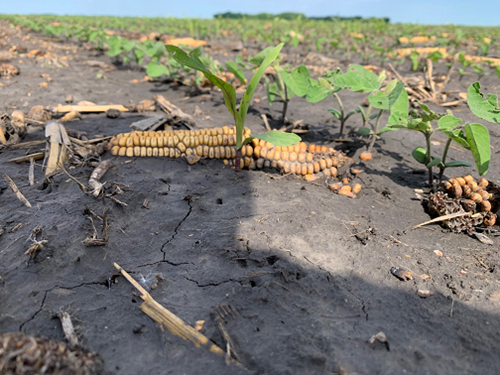Agronomy Update: Summer Time Crop Concerns
BY DAIRYLAND SEED AGRONOMY TEAM
"We'll Take the Rain; You Keep the Wind" (Evaluating Wind Tolerance)
The mantra of the past two weeks! The rain showers of the past 10 to 14 days will push many fields through a successful pollination. Unfortunately, many of these weather systems were high-energy, resulting in high winds that damaged corn fields in particular. We have been getting scattered reports of wind damaged fields, but in other cases we are receiving positive feedback about performance through the storms.
The Agronomy Team at Dairyland Seed and Corteva Agriscience continuously focuses on bringing the best products to the marketplace. Every time we walk a field, we have current and future success in mind. Part of this focus is evaluating hybrids for tolerance to wind damage -- both in natural and simulated settings. We value both methods since wind speed and hybrid tolerances are not the only factors in troubled fields. Root depth, insect pressure, nutrient imbalances and even our planting practices (depth and population) can influence standability, making for complex evaluations.
During the wind events of the last couple weeks, crop growth stage was a leading factor. Corn is most susceptible to summer lodging as it passes between V8-VT because the crop is rapidly growing and plant cells are fresh and crispy for a period of time before the stalk “matures” and allows for flexing. It’s kind of like an awkward teenager. This is a really poor time for wind events so we need to factor planting date and hybrid maturity when evaluating products for susceptibility to wind.
For example, a recent visit to a plot in southern Wisconsin revealed wind damage across all brands of corn hybrids in the plot after a wind event. The spectrum of lodging followed product maturities in this case. Not a single plant leaned over in the 98 to 103-day products as they were very close to tasseling and just past the most susceptible growth stages of V8-10. The 110+ day products were still in the stages of most rapid growth (further from tasseling) and just about every plant suffered damage. Comparing a 98-day product to a 110 day product would be like comparing apples to oranges in this case. Similar cautions should be made when looking at products of similar maturity with very different planting dates.
While we strive for products that are as weather-proof as possible, we know that Mother Nature holds the upper hand sometimes. These are the times that we button down our learning caps and get our boots muddy. The great news in all of this: anyone who has grown corn long enough, knows how it can surprise us with its ability to stand back up a few days later.
The Cup Runneth Over
Yes, we have an abundance of cupped soybeans again this year as we have in the past growing seasons. Cupping of soybeans can have a couple causes and merit a bit of discussion.
The most prevalent theory, in many cases, is off-target movement of dicamba type products either by vapor or particulate drift. Contrary to what one may think given the popularity of Enlist E3™ soybeans, close to 80 percent of the market is still NOT Enlist E3™ traited. Most of that number is made up of Xtend soybeans and most all still were treated with dicamba of some sort. Add to that the use of dicamba in corn acres, and there is plenty of dicamba being applied in 2020. So, the possibility is pretty good we are seeing dicamba issues in those fields with cupped beans.
That said, we wouldn’t be good agronomists if we didn’t throw in a little ambiguity, a little bit of “maybe”, it “could” be or the best of all “it depends” . Other theories related to causes of cupped soybean include environmental stress, insects such as spider mites or leafhopper, adjuvants added to the spray solution with post emerge herbicides and simply the stress of other post applied herbicides.
Volunteer Corn Control

The photo above shows a volunteer corn plant in a soybean field. Another word to describe this volunteer corn plant is “it’s a weed,” which is a plant that competes with the intended crop for space, water, light and nutrients. Over the years I have been told that “a volunteer corn plant here and there in your soybeans is not worth the cost to kill it” and in one memorable instance “my elevator doesn’t dock for it, and really, when is the last time you were able to get $8-$9 for your corn?”
Various studies from land grant institutions have shown that some of the more apparent concerns with volunteer corn is the fact that it reduces your soybean yield 10 to 20 percent. So how much corn equates to a 10 percent yield loss? Only about six volunteer corn plants per 100 foot of row will achieve that amount of loss. Another rule of thumb is 2.4 volunteer corn plants per 100 square feet can reduce yield by 10 percent. (For those of us that used to walk beans with a hoe…that hoe is about 5 feet in length. So, if you took two hoe lengths long and two hoe lengths wide that would give you 100 square feet.) These yield losses are on top of the water and nutrients that were not used by the intended crop.
Some of the unintended consequences of not controlling volunteer corn, is that this weed, can attract corn rootworm beetles to those plants and then potentially lay eggs, which reduces the benefits or advantage of a crop rotation, thus creating a bigger threat to next year's corn crop. There has been some discussion that by not controlling volunteer corn in soybeans (if the previous year’s corn crop was a B.t. corn rootworm event) that with the potential of reduced levels of expression of B.t. in those plants, we could select for resistance to these B.t. events. If this were to happen, it is not a good scenario for anyone.
Another concern that I have is by having these volunteer corn plants, we are also allowing diseases such as Northern Corn Leaf Blight, Gray Leaf Spot, Goss’s Wilt as well as numerous others an opportunity to infect plants in the rotation year, which potentially sets up the next or future crops for more disease pressure.
Lastly, if you have already controlled your volunteer corn, good job. If you are still in the process of doing that and using a volunteer corn product to accomplish this, remember you will need to increase your volunteer corn herbicide rate 30 to 50 percent when tank mixing with a broadleaf herbicide. If you have questions about this or other Agronomic topics, please contact your Dairyland Seed Agronomist.
Corteva Technology Use Agreements
All growers with orders for any Corteva Agriscience brand seed product, regardless of crop or trait (including non-GM products) need to have a signed Corteva Technology Use Agreement in place by September 1. Growers should sign the Corteva Technology Use Agreement electronically at www.agcelerate.com. Signing electronically is preferable, however, paper copies are available at www.traitstewardship.com.
 |
 |
 |
 |
 |
| Brian Weller Western Region 507.456.3034 |
Dan Ritter Central Region 219.863.0583 |
Branden Furseth Northern Region 608.513.4265 |
Rod King Eastern Region 574.596.6721 |
Terry Jones Eastern Region 419.630.3115 |
